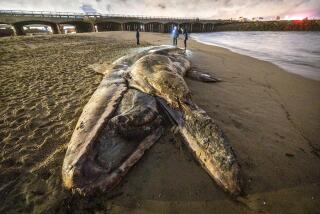Are seals mutilating and killing porpoises? Scientists investigate
A gruesome series of killings has left porpoises stranded on the shores along the North Sea, and scientists now think they have a culprit: gray seals.
Turns out those adorable gray seals aren’t so cuddly after all. The findings, described in the Proceedings of the Royal Society B, reveal a disturbing trend that could potentially alter the ecology of harbor porpoises.
Harbor porpoises, formally known as Phocoena phocoena, have been washing up along the coasts of the southern North Sea in Europe, with deadly wounds whose origins were a mystery. Were the porpoises slashed by boat propellers? Were they bycatch victims, trapped by fishing nets and cut up by fishermen? Were the wounds the result of scavengers preying on dead or dying animals?
A disturbing explanation came to light when DNA from gray seals (known as Halichoerus grypus) was discovered in bite wounds on three mutilated harbor porpoises. But it wasn’t clear whether this was an anomaly, or a common way for the poor porpoises to meet their demise.
For the study, a team of researchers from the Netherlands analyzed photographs of 1,081 dead harbor porpoises stranded between 2003 and 2013. Of those, 271 of the animals’ corpses were fresh enough that the scientists could clearly see gray seal-related wounds on their bodies. A quarter of those showed bite and claw marks that matched the marks found on the porpoises whose wounds held gray seal DNA.
“If dead stranded and autopsied harbor porpoises are representative of porpoise deaths in the region, then gray seal attacks (more than 17%) together with fisheries bycatch (approximately 20%), infectious disease (approximately 18%) and emaciation (approximately 14%) are the most important causes of death for harbor porpoises in the southeastern North Sea,” the study authors wrote.
And that’s a conservative estimate, given that many of the more far-gone porpoise corpses could potentially have been victims of an attack. On top of that, any victims whose bellies or chests had been ripped open would have sunken and decayed fast.
Given that the attacked animals tended to be young and healthy with a thick layer of blubber, the scientists think that the seals are killing the porpoises to get to those valuable, high-calorie stores of fat.
This isn’t the first time scientists have raised the alarms about this behavior. In 2012, a team of scientists in Belgium (which also sits along the southern North Sea) described this behavior – which appeared to be a relatively new development – in the journal Aquatic Mammals.
“The gray seal is an opportunistic predator, feeding on a variety of fish and cephalopods, and occasionally even on crustaceans and seabirds,” the Belgian researchers wrote, “but predation on harbor porpoises, or any other marine mammal, had to our knowledge never been described.”
Their findings revealed what the Belgian scientists called “a change in the feeding strategy of a top predator.”
If it is indeed a new phenomenon, how did the seals start to target porpoises? That remains unclear, but the Dutch scientists who did the new study have a suggestion: It’s possible that fishermen played a part. The seals might have started off eating porpoises trapped in nets, and then decided to start hunting on their own, the authors wrote.
“It is tempting to speculate that harbor porpoises entangled in such nets may have triggered gray seals to turn from scavenging to attacking live animals,” they wrote.
This kind of predation pressure from seals could have long-term effects on the porpoises. Since the victims are typically young, healthy porpoises approaching breeding age, it could be affecting how many offspring are produced – and future population levels.
It could also affect the porpoises’ behavior. They may stop building up fat reserves, so they can be leaner and more easily escape such attacks – but this would make these small whales more vulnerable to starvation. It could also mean they may change their diving behavior when seals are nearby or avoid feeding ground where the fish are plentiful, but where they may also be attacked.
Humans, beware: The authors end on a somewhat worrisome note.
“Many of the mutilated porpoises were found on Dutch shores used frequently by human bathers and surfers, and there would appear to be no a priori reason why humans may not be at risk from gray seal attacks,” the study authors wrote.
It’s a seal-eat-porpoise world out there. Follow @aminawrite for more updates from the animal kingdom.







